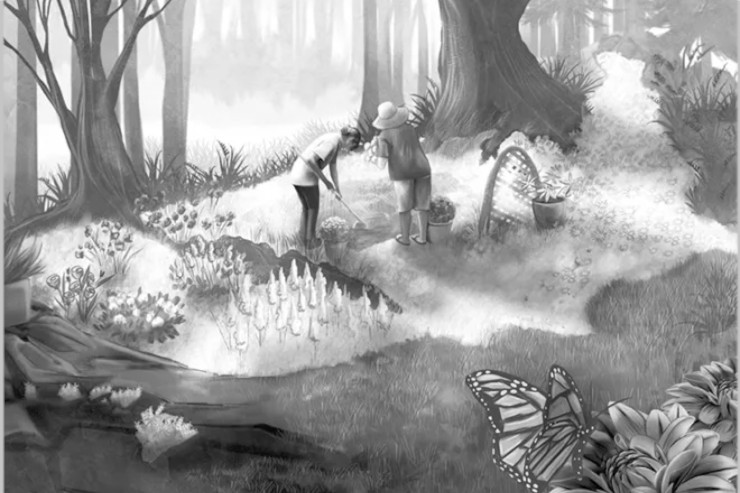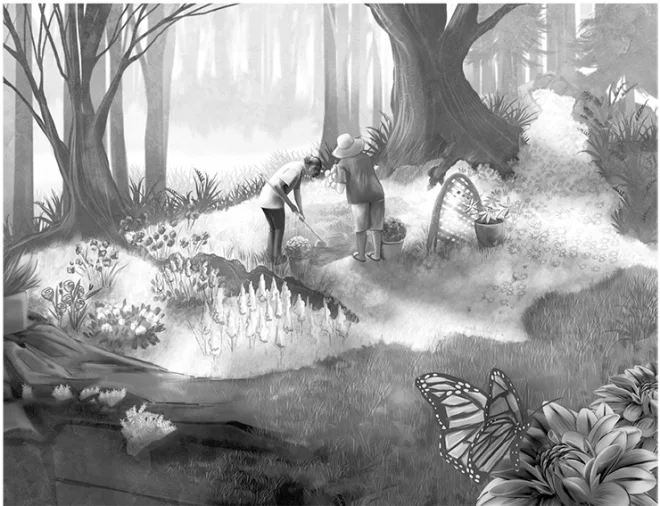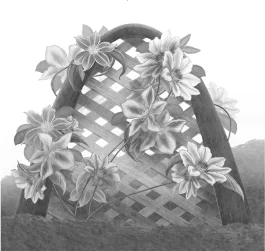
What comes to mind when you think about country garden inspiration? Perhaps you envision vast swaths of brilliant flowers underneath a blue sky. Maybe there are some wispy clouds floating across the horizon.
Or maybe your idea of country garden inspiration is a perfectly landscaped field, with herbs and vegetables in neat rows, a collection of fruit trees standing next to a stone path that winds its way through blueberry bushes and into a thicket of pine and birch trees.
That’s certainly what I might think of. Mary Whitsell, however, takes country garden inspiration to another level. In her story, The Shape of America, she relays her story of moving to an old house in Scotland with “a large, neglected garden that was surrounded by conifer trees.”
Overgrown weeds, tall grass, thick surface roots, stones, and brambles covered whatever garden there may have been at one time. Mary tried to ignore the garden as she concentrated on home renovations until one day she couldn’t take it anymore.
Hour and hours and days later, with weeds gone, stones moved, and brambles cut back, Mary was surprised to discover that her garden wasn’t just any old garden. There was something special about it. Here’s her story. I hope that you’re able to find the inspiration here to help you create the garden you want.
Real or Metaphorical, You’ll Find A Lot of Country Garden Inspiration Throughout the Stories Here in GreenPrints.
This story comes from our archive spanning over 30 years, and includes more than 130 magazine issues of GreenPrints. Pieces like these that imbue the joy of gardening into everyday life lessons always brighten up my day, and I hope it does for you as well. Enjoy!

The Shape of America
Both my garden and our country.
By Mary Whitsell

Fourteen years ago, our family moved into an old house in Scotland which stood in the middle of a large, neglected garden that was surrounded by conifer trees. Our kitchen window looked out over a patch of worn-out grass and overgrown weeds. For months after we moved in, we were too busy renovating the house to do much with this small garden. Every time I gazed out over the shabby weeds and miserable turf, it depressed me. Every time friends came to visit, it embarrassed me. One day, I couldn’t bear it any longer. So I began to tackle it.
First I waged war on the weeds—mainly brambles, and clumps of fiery orange montbretia so vigorous, persistent, and abundant that I could have supplied half of Scotland with everything I pulled out. But there was also creeping buttercup, purslane, and dock weed, all depressingly healthy and plentiful.
That’s when I discovered that what lawn still remained had been planted over the remains of a stone wall. Some of the rocks could not be shifted, especially those that ran under the thick surface roots of the pine trees. But I managed to dig out most of them eventually—with great effort. Several wheelbarrows full of stones later, I’d ruined two shovels, and my back was killing me.
And yet for all my efforts, I saw to my discouragement that I had made the biggest mess: The grass had to be replanted, and gaping holes where the rocks had been needed refilling with topsoil, which took ages and did nothing for my aching back. Gardening friends assured me that it wasn’t as bad as it looked—that you have to make a mess for any lasting improvements to be achieved.
I tried to accept these wise words, but when the lawn grew back, it was sadly underwhelming: The pine trees created so much shade that moss thrived and crowded out most of the grass.
And then, gradually, grass and moss reached a kind of symbiosis, the grass pushing up through the moss in patches of lime and Kelly green that soothed the eyes and were comfortable to walk on. In the middle of the garden, I created a rock garden which I filled with aubrietia, saxifrage, and other flowers. I edged the lawn, creating fanciful scalloped curves instead of boring, straight lines, and finally I laid down slates along the sides.
The end result was satisfying, but the best thing of all was something I’d managed to do without even realizing it. One day I was at my kitchen window gazing down on my hard work with pride—and I gasped out loud when I saw what I had unwittingly done: I had created the shape of the United States of America.
The border separating our garden from the neighbors’ ran straight along the top left of the garden, right to the point where a series of deep tree roots rippled through the turf, creating loopy trenches exactly where you’d find the Great Lakes. New England extended way up into the pine trees, Maine tapering into a large peninsula which vanished into their rock-bound roots. The Eastern seaboard curved in all the right places. Delaware and Maryland were surrounded by an ocean of montbretia (I meant what I said about persistent), and Florida was a graceful loop of grassy turf that stretched into a sea of perpetual forget-me-nots. The Gulf of Mexico was in a half moon that tapered down to a V-shape just where you’d find Brownsville, Texas, and California even had a little notch halfway up its border right where San Francisco would be. When I saw what I’d unwittingly done, I went with it: Just off the northern border of Washington, I added a huge square pot of catnip for our cats and began to refer to this as Alaska, and in the sea of slate way off the coast of California, I left a few patches of self-heal, christening it Hawaii.
I called my garden America. Working on America every day even took away some of my homesickness. The many similarities between the real America and my garden version struck me as I weeded and mowed and raked. A thick, bumpy tree root, ribbed with large stones, ran just like the Rockies, from the Canadian border, disappearing under the prairie states. Just behind this, my oldest daughter helped me put in a St. Louis arch, at the base of which we planted clematis and honeysuckle.
In the beds, I planted whatever I could get my hands on. So Virginia creeper and carnation freebies thrived next to three-for-the-price-of-one ageratum, nasturtiums, and daffodils. Sweet Williams, marigolds, and freesias cheerfully bloomed next to my prized Nellie Moser clematis. I deliberately chose flowers from different lands: wisteria and peonies from China, African natives like freesias and amaryllis, marigolds and cosmos from Mexico, bluebells from Scotland, the host country, and of course, native Americans like California poppies and columbine. My America wasn’t a melting pot; it was a wild and crazy salad. Plants might occasionally clash, but overall they lived together in colorful harmony.
Visitors who came to our house were always taken up to the kitchen and, from the window, shown America—my America, which I created with my own two hands, with backbreaking labor, with whimsy, and with love. On the rare occasions I man-aged to persuade my daughters to garden with me, my garden was both handy and educational. Handy, because if they asked me where I wanted the wheelbarrow, I could say, “Off the tip of Maine” or “Where Hawaii is.” Educational, because occasionally my girls learned things: “No, that’s Georgia, keep going until you get to North Carolina!” Friends humored me by noticing that Chicago actually had lakes in it after heavy rain, or when Arizona and Nevada—which got the most sun—needed watering, or that Mississippi and Louisiana were flooded again.
I was proud of my America. Even friends who weren’t always 100% approving of my slapdash and unorthodox gardening skills commented positively, affirming what a good thing I’d achieved. “Well,” my friend Dina said slowly as she appraised it for the first time, “it’s certainly different. A little bit of everything.” No comment could have pleased me more: a little bit of everything. In short, a crazy and eclectic experiment, and how entirely appropriate.
And then in 2013, we left Scotland to work in China. Although our house was never uninhabited, none of the people who lived in it were gardeners, and we couldn’t afford to hire anyone to do more than occasionally trim the hedge or mow the lawn. Every two years we went back to Scotland during the summer to do an entire year’s worth of gardening in one month (something I absolutely do not recommend). And every year we went back, America looked worse for wear. The arch, never very stable in the first place, looked wobblier every year. The rock garden, which needed the kind of tender loving care you have to provide on a weekly basis, began to look seedier. Montbretia, my nemesis, began to creep back in over the Canadian border. Bit by bit, America was starting to slide downhill.
This past year, 2018, was the worst of all. When we got back, the first thing we noticed was that the wooden arch had toppled over in a Winter storm and lay scattered in pieces from Kansas to the Dakotas. Florida, Georgia, and the Carolinas had disappeared into a sea of weeds, and parts of the roof from our garden shed, blown down in the same storm, were everywhere. The rock garden had been invaded by dandelions and dock weed, and the Canadian border was so badly overrun with montbretia you couldn’t tell where America met Canada. The Gulf of Mexico was full of something that looked worryingly like giant hogweed; the California and Oregon coastlines had merged into the slate around them, which was overgrown with moss; Alaska had been devoured right down to the roots by the neighborhood cats; and Maine was a scary mess of thorny brambles. Worst of all, the grass had grown so high it had doubled over on itself and lay in sodden clumps that could no longer be cut by a lawn mower, and fallen branches and pinecones from the pines lay buried in it.
In short, my beautiful America looked like the sad lot on the block where nobody can be bothered to pick up the beer cans or the rotting car engine rusting in the weeds. Just looking at America made me want to sit right down and cry. All that work I’d put into it—the hours of exhausting labor! The rocks I’d dug out, the bags of soil and leaf mold and sharp sand I’d hefted, the planting and weeding and endless fussing. All for nothing!
For a week, I couldn’t bear to go near America. Plenty of other things needed fixing inside the house and in other areas of the garden, so I busied myself with less daunting chores and averted my eyes every time I had to walk past it.
And then one day I could no longer bear it. The fallen arch was removed with the help of neighbors. I dismantled the rock garden, digging up all the saxifrage and aubrietia and putting them in an area that got more sun. I raked up moss, dug out montbretia with a vengeance, and hacked away at the thorny brambles. I raked the borders, removing tree seedlings and foot-high dock weed. And finally, I sat down with a bread knife and started hack-ing at the soggy grass that was—I solemnly swear—thigh high in places. My husband and daughter fixed the shed roof and carted away loads of branches, grass clippings, and debris to burn.
When we were done, America looked like an invalid who’d had his hair cut by a five-year-old. Some of the grass had been choked out by moss; patches of earth peeked out, glum and bare. Fragments of montbretia poked out here and there like whiskers on a badly shaved face. Still, all in all, America looked better. Salvageable. “Mom,” my daughter exclaimed, balancing on the tree-root Rockies, one hand on the wheelbarrow as she surveyed our work: “It looks like America again!” And she was right: The shape was recognizable. America was still there—it had always been there, even in all that mess.

A few days later, we said goodbye to our house and garden. Before we loaded up the car, I stood staring out at the garden. It still looked pretty miserable, to be honest, and yet so much better. How grateful I was for all the help I’d had—indispensable help from our kind neighbors with their superior garden tools and my daughters with their younger backs and stronger legs (and the great idea of using the breadknife on the grass). And I knew that I would be back to garden again, with more help, and that better times for America would come—better than ever before.
Things haven’t been easy, but my garden is still there: still unique, still diverse, still cherished. And with love and hard work, America will survive and flourish, too—I know it will. Both of my Americas. ❖
By Mary Whitsell, published originally in 2019, in GreenPrints Issue #118. Illustrated by Christina Hess

Have you ever had a garden with a unique shape? I’d love to read about it in the comments.



